

petra ritter-mansfeld
enthousiastic ;-)
Qualitative Medienforschung: Ein Handbuch.
How Online Learning Is Like Babysitting. Taking part in an online course – whether as a student or teacher – is like suddenly being asked to take care of someone else’s three-year old. A very rambunctious three-year-old. And even though it may have seemed easy enough when you agreed, it demands far more attention that you could ever have imagined. All day long, as you attempt to carry on with the rest of your life it interrupts what you are doing and tosses toys at you and needs to be fed. It may play quietly for a few minutes, but only temporarily.
As soon as you try to put it down for a nap, it starts wailing uncontrollably. The Online Teacher’s Perspective You took the “babysitting” test for online learning/teaching and easily passed: Yes I am self-motivated, Yes I like to communicate in written form, Yes I can organize my schedule, Yes I can meet deadlines. You knew you’d need to allow “space” in your schedule – but how can anyone allow this much space in their schedule? Abandon The Rest Of Your Life The Realization. Massive Open Online Course. Massive Open Online Course (deutsch massiver offener Online-Kurs), kurz MOOC, bezeichnet Onlinekurse, die für alle eingeschriebenen Studenten offen sind und große Teilnehmerzahlen aufweisen.
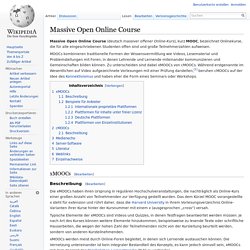
MOOCs kombinieren traditionelle Formen der Wissensvermittlung wie Videos, Lesematerial und Problemstellungen mit Foren, in denen Lehrende und Lernende miteinander kommunizieren und Gemeinschaften bilden können. Zu unterscheiden sind dabei xMOOCs von cMOOCs. Während erstgenannte im Wesentlichen auf Video aufgezeichnete Vorlesungen mit einer Prüfung darstellen,[1] beruhen cMOOCs auf der Idee des Konnektivismus und haben eher die Form eines Seminars oder Workshops.
5 Potential Ways MOOCs Will Evolve. In order to understand where MOOCs are heading (at least taking a stab at guessing their future), it’s important to know what the stated goals are. In case you’re still new to MOOCs, here’s a helpful rundown of the guiding principles behind MOOCs : Aggregation. The whole point of a connectivist MOOC is to provide a starting point for a massive amount of content to be produced in different places online, which is later aggregated as a newsletter or a web page accessible to participants on a regular basis. This is in contrast to traditional courses, where the content is prepared ahead of time. The second principle is remixing, that is, associating materials created within the course with each other and with materials elsewhere. Behind-The-Scenes: How MOOCs Are Getting Money. Opening up education through innovation. Introducing the Collaboration Curve - John Hagel III, John Seely Brown and Lang Davison - John Hagel III and John Seely Brown.
By John Hagel III, John Seely Brown and Lang Davison | 2:38 PM April 8, 2009 There’s a classic story in economics primers illustrating the power of network effects.
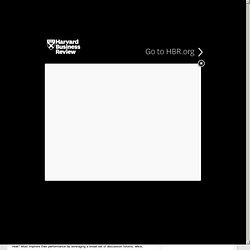
It tells how the first fax machine gave little value to its owner–after all, there was no one else with whom to send and receive faxes. As time went by, however, the value of that first machine increased as other people bought fax machines, and soon its owner could send faxes to the far corners of the earth, and receive them in return. The point of the story is how the value of a node in a network rises exponentially as more nodes are added to it. These are called network effects. A Tale of Two MOOCs @ Coursera: Divided by Pedagogy. The Web as a classroom is transforming how people learn, is driving the need for new pedagogy; two recently launched courses at Coursera highlight what happens when pedagogical methods fail to adapt.
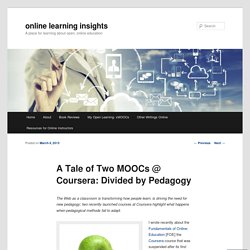
Divided pedagogy I wrote recently about the Fundamentals of Online: Education [FOE] the Coursera course that was suspended after its first week and is now in MOOC hibernation mode. Over thirty thousands students signed up for the course hoping to learn how to develop an online course. It was a technical malfunction when students were directed to sign-up for groups through a Google Doc that shuttered the course, along with hundreds of student complaints about lack of clear instructions, and poor lecture quality. The course was suspended on February 2, and there has been no word yet as to when it will resume :(. The Tale of the Two What made e-Learning and Digital Cultures successful and FOE not? Our current higher education system is grounded in behaviorist and cognitive theories.
References. The 7 Most Powerful Ideas In Learning Available Right Now. Tomorrow’s Learning Today: 7 Shifts To Create A Classroom Of The Future by Terry Heick For professional development around this idea or others you read about on TeachThought, contact us.
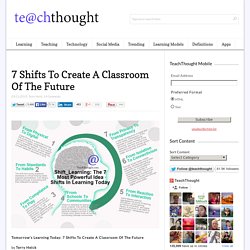
Let’s take a look at the nebulous idea of the “classroom of the future.” This is all subjective, but it’s worth talking about. So let’s talk. Below are some ideas that are truly transformational–not that they haven’t been said before. And the best part? But therein lies the rub: Tomorrow’s learning is already available, and below are 7 of the most compelling and powerful trends, concepts, and resources that represent its promise. The Challenge of Implementation. Awesome Chart on " Pedagogy Vs Andragogy " Adult learning is a vast area of educational research and probably one of the most complicated.
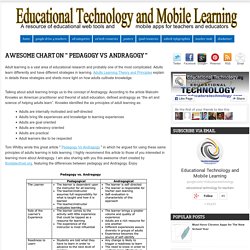
Adults learn differently and have different strategies in learning. Adults Learning Theory and Principles explain in details these strategies and sheds more light on how adults cultivate knowledge. Talking about adult learning brings us to the concept of Andragogy. According to the article Malcolm Knowles an American practitioner and theorist of adult education, defined andragogy as “the art and science of helping adults learn”.